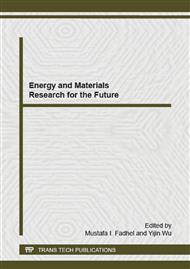[1]
Nanda A K, Wicks D A. The influence of the ionic concentration, concentration of the polymer, degree of neutralization and chain extension on aqueous polyurethane dispersions prepared by the acetone process[J]. Polymer, 2006, 47(6): 1805-1811.
DOI: 10.1016/j.polymer.2006.01.074
Google Scholar
[2]
Yun J K, Yoo H J, Kim H D. Preparation and properties of water-borne polyurethane-urea/poly (vinyl alcohol) blends for high water vapor permeable coating materials[J]. Macromolecular Research, 2007, 15(1): 22-30.
DOI: 10.1007/bf03218748
Google Scholar
[3]
D.K. Chattopadhyay, K.V.S. Raju. Structural engineering of polyurethane coatings for high performance applications[J]. Prog. Polym. Sci, 2007, 32: 352-418.
DOI: 10.1016/j.progpolymsci.2006.05.003
Google Scholar
[4]
Zhang C Y, Zhang X Y, Dai J B, et al. Synthesis and properties of PDMS modified water-borne polyurethane-acrylic hybrid emulsion by solvent-free method[J]. Progress in Organic Coatings, 2008, 63 (1): 238-244.
DOI: 10.1016/j.porgcoat.2008.05.011
Google Scholar
[5]
LIU Lingling, ZHAO Tao. Effect of chain extenders on the application of aqueous polyurethane dispersions in pigment dyeing[J]. Proceedings of the 12th International Wool Research Conference , volume(I), 2010: 363-367.
Google Scholar
[6]
Lee S K, Kim B K. High solid and high stability waterborne polyurethanes via ionic groups in soft segments and chain termini[J]. Journal of Colloid and Interface Science, 2009, 336(1): 208-214.
DOI: 10.1016/j.jcis.2009.03.028
Google Scholar
[7]
Shen Yiding, Yang Yan, Lai Xiaojuan. Synthesis and properties of silane modified self-crosslinking aqueous polyurethane and its film performance[J]. Paint & Coatings Industry, 2010, 40(8): 25-30.
Google Scholar
[8]
ZHONG Ni, YUAN Qiao-long. Preparation and Properties of Water-borne Cationic Polyurethane[J]. The Chinese Journal of Process Engineering , 2008, 8(2): 368-317.
Google Scholar
[9]
P. Michael Fletcher and Sam V. Nablo. Textile Applications for EB/UV Curing[J]. Journal of Industrial Textiles. 1991, 21: 102.
DOI: 10.1177/152808379102100204
Google Scholar
[10]
William K., Walsh, et al. Radiation Curing Of Pigment Prints On Texties[J]. Radiation Physics and Chemistry, 1979, 14: 893-904.
DOI: 10.1016/0146-5724(79)90125-0
Google Scholar
[11]
M. Tielemans, P. Roose, P. De Groote, J.C. Vanovervelt, Prog. Org. Coat. 55 (2006) 128.
Google Scholar
[12]
J.W. Yang, Z.M. Wang, Z.H. Zeng, Y.L. Chen, J. Appl. Polym. Sci. 84 (2002) 1818.
Google Scholar
[13]
Chenyan Bai, Xingyuan Zhang, JiabingDai. Synthesis and characterization of PDMS modified UV-curable waterborne polyurethane dispersions for soft tact layers[J]. Progress in Organic Coatings. 60 (2007) 63–68.
DOI: 10.1016/j.porgcoat.2007.07.003
Google Scholar
[14]
Chen Weitao. Study on the properties of waterborne polyurethane systems and their aoolication[D]. Tianjin University Of Science and Technology, (2006).
Google Scholar
[15]
LI Juan, WANG Jing-cun, et al. Study on Microphase Separation of H12MDI based Polyurethane Elastomers[J]. China Plastic Industry, 2010, 38(6): 47-51.
Google Scholar


